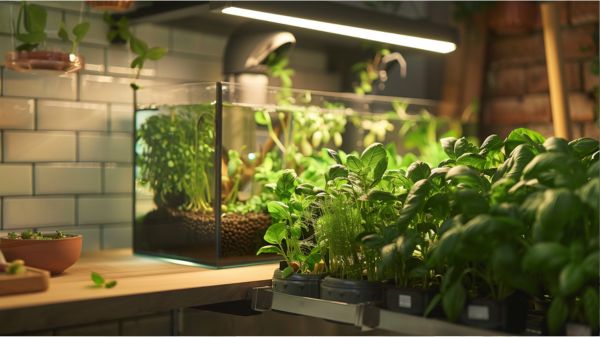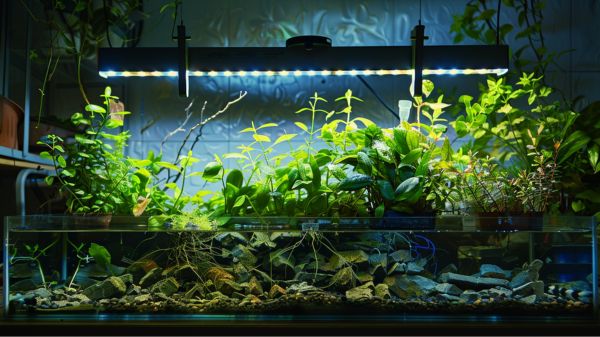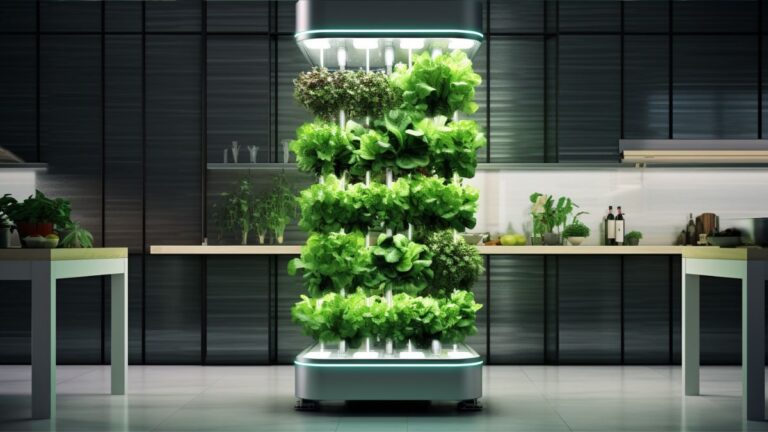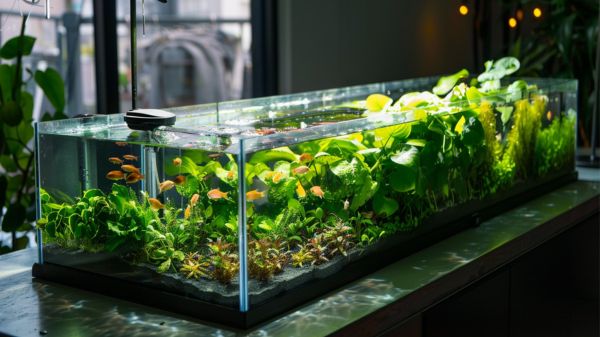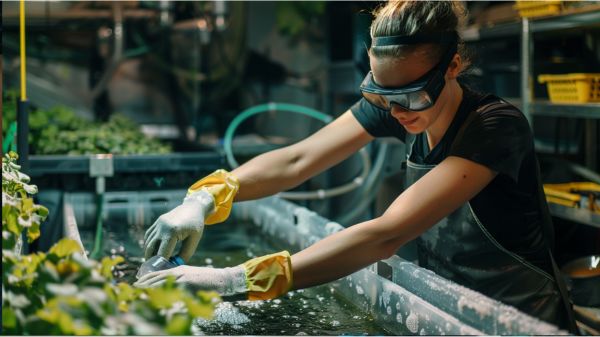Essential Supplies for Your Indoor Aquaponic Garden
In the domain of indoor aquaponic garden, securing essential supplies becomes a cornerstone of success. From the foundational fish tank to the intricate water pump system, every component plays a critical role in nurturing a thriving ecosystem within your home.
The synergy between aquatic life and plant growth is a delicate dance that requires precision and foresight. As we explore the intricate web of elements required, it becomes evident that each piece serves an important function in creating a harmonious balance.
Can you envision the intricate network of connections that sustain this modern marvel of sustainable agriculture?
Key Takeaways
- Choose a robust tank for your aquaponic system based on the scale and water volume needed.
- Select pumps and aeration systems that promote healthy root growth and efficient water circulation.
- Set up proper plumbing and filtration to ensure smooth water flow, waste management, and nutrient distribution.
- Use monitoring tools like testing kits and digital meters to maintain water quality and regulate the nitrogen cycle.
Tank and Grow Bed
When setting up an indoor aquaponic system, choosing a robust, food-grade fish tank is paramount to ensure the success of your garden. The fish tank serves as the central hub of the aquaponic system, providing a habitat for the fish whose waste will nourish the plants in the grow bed. It is essential to select a tank that can securely hold water without flexing, as this could compromise the structural integrity of the system.
Common options for fish tanks include polyethylene tanks, IBC water totes, 50-gallon water drums, or square totes. The size of the fish tank should be determined by the scale of your aquaponic system to ensure there is enough water volume to support both the fish and plants. Additionally, incorporating a solid lifting overflow system will help efficiently manage water levels in the tank.
Before proceeding with your aquaponic setup, make sure that the fish tank meets the necessary qualifications for a successful aquaponics system. It is advisable to have a testing kit on hand to monitor water parameters and ensure ideal conditions for both fish and plants to thrive.
Water and Air Pumps
In establishing an indoor aquaponic system, the selection and proper functioning of water and air pumps play a pivotal role in ensuring the circulation of oxygen and nutrients essential for the well-being of both plants and fish.
When choosing pumps for your aquaponics system, it is important to take into account the following:
- Water Pump Circulation: Opt for a water pump capable of circulating the entire volume of your fish tank at least once per hour to facilitate ideal oxygenation and nutrient distribution within the system.
- Air Pump Aeration: Consider incorporating an air pump to enhance aeration, promoting healthy root growth in plants and supporting beneficial bacteria, ultimately contributing to a thriving ecosystem.
- Energy-Efficient Operation: Select water pumps with adjustable flow rates tailored to the size of your aquaponics system. Opting for energy-efficient models not only minimizes operational costs but also reduces environmental impact while maintaining proper water circulation.
Ensuring the proper sizing and positioning of both water and air pumps is essential for maintaining water quality and fostering the overall health of your indoor aquaponics system.
Plumbing and Filtration
Efficient plumbing and filtration are integral components of indoor aquaponic systems, connecting the fish tank to important filtration elements for best water circulation and waste management.
Plumbing in aquaponics systems involves strategically linking the tanks to filtration components such as biofilters and settling tanks. This setup guarantees that water flows smoothly through the system, facilitating the removal of solid waste and the conversion of harmful substances like ammonia into beneficial nutrients like nitrate.
Quality plumbing materials, including PVC pipes, connectors, and hoses, play a vital role in maintaining the functionality of the system.
Filtration components like swirl filters and biofilters are essential for maintaining water quality, which is essential for supporting healthy plant growth in indoor aquaponic gardens.
By investing in efficient plumbing and reliable filtration systems, aquaponic enthusiasts can create a sustainable environment where fish and plants thrive harmoniously while promoting best water quality.
Grow Media and Seeds
Selecting appropriate grow media and high-quality seeds is essential for establishing a successful indoor aquaponic garden. The right grow media, such as expanded clay pellets, rockwool, or coconut coir, provides a supportive environment for plant roots in the aquaponic system. It is important that the grow media is pH neutral, offers good aeration, and retains water effectively to promote best plant growth.
When choosing seeds for your indoor aquaponic garden, opt for high-quality seeds of plants like lettuce, herbs, or leafy greens. Consider selecting organic or non-GMO seeds to align with sustainable growing practices and make the health of your plants. Before planting the seeds in the grow media, take the time to germinate them properly. This initial step will kickstart the growth of your plants in the indoor aquaponic setup, setting a strong foundation for a thriving garden.
Testing Kits and Meters
To guarantee the peak functioning and health of your indoor aquaponic system, monitoring water quality through the use of testing kits and meters is imperative. Testing kits for pH, ammonia, nitrite, and nitrate levels play a critical role in maintaining a balanced aquaponics setup.
Digital pH meters offer accurate and instant readings, enabling you to fine-tune pH levels for ideal plant and fish health. Ammonia test kits are essential to prevent harmful ammonia buildup that can endanger fish. Similarly, nitrite and nitrate test kits help secure a well-regulated nitrogen cycle, providing essential nutrients for healthy plant growth.
Consistent use of these testing tools is crucial for sustaining a stable environment in your indoor aquaponic garden, fostering the prosperity of both your plants and fish. By actively monitoring water quality with these test kits and meters, you can address any imbalances promptly and promote a thriving ecosystem within your aquaponic setup.
Frequently Asked Questions
What Is Needed for Aquaponics?
In aquaponics, essential elements include lighting options, nutrient balance, plant selection, water quality, pest control, temperature regulation, and system maintenance. Understanding these components is important for successful indoor aquaponic gardening, ensuring best plant growth and fish health.
What All Do Plants Need to Grow Indoors in an Aquaponics System?
Plants grown indoors in an aquaponics system require proper lighting for photosynthesis, ideal nutrient levels for growth, quality water circulation, controlled temperature, suitable plant selection, effective pest management, and balanced pH levels to thrive.
How Do I Start an Indoor Aquaponics System?
To start an indoor aquaponics system, focus on lighting setup, water filtration, fish selection, plant nutrients, temperature control, system maintenance, and harvesting schedule. Create a symbiotic environment for fish and plants to thrive indoors.
What Equipment Is Used in Aquaponics?
Aquaponics systems utilize essential equipment like fish tanks, grow beds, water pumps, aeration systems, and beneficial bacteria to create a symbiotic environment. Lighting, water quality, nutrient supplements, pest control, fish selection, system maintenance, and harvesting techniques are crucial components for system success.
Conclusion
In summary, ensuring you have the essential supplies for your indoor aquaponic garden is important for the success of your system.
From the fish tank and grow beds to water and air pumps, along with proper plumbing and filtration systems, grow media, seeds, and testing kits, each component plays a significant role in maintaining a healthy environment for both your fish and plants.
By carefully selecting and maintaining these supplies, you can enjoy a thriving aquaponic garden in your own home.
